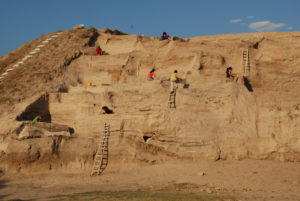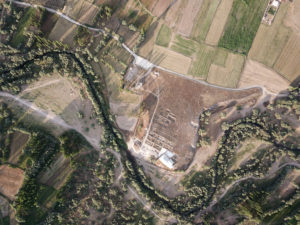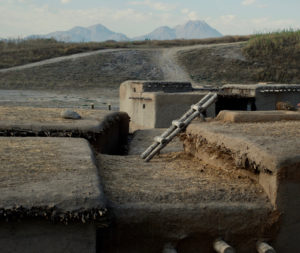
The transition from hunting and gathering to farming and herding around 10,000 B.C. is thought by many scholars to have helped to establish the foundation for civilization as we know it.
At the ancient Neolithic settlement of Asikli Höyuk in central Turkey, archaeological evidence suggests that humans began domesticating sheep and goats around 8450 BC. This evolved over the ensuing 1,000 years, until the settlement became heavily dependent on domesticated animals for resources.
Among the techniques and evidence used to reveal this scenario of life at Asikli Höyuk was an approach recently employed by Jordan Abell, a graduate student at Columbia’s Lamont-Doherty Earth Observatory, and his colleagues. The team measured the scale and pace of early animal domestication and herding evolution at the site. By examining midden soil layers, they could see that they were highly enriched with sodium, chlorine, and nitrate salts — elements commonly found in human, goat and sheep urine. Working with Turkish archaeologists, including Istanbul University’s Mihriban Özbaşaran, who directs the Asikli Höyuk excavation, the team collected 113 samples from across the site — from middens (trash piles) to bricks and hearths, spanning different time periods — which revealed patterns in the sodium, nitrate and chlorine salt levels. They found a five to 10 times increase in salts between about 10,400 BP to 10,000 BP, and a 10 to 1000 times increase between 10,400 and 9,700 BP. This suggested an increasing reliance upon and eventual domestication of sheep and goats over this time. Based on these salt concentrations, Abell et al. estimate that about 1,790 humans and animals lived and urinated on the site per day for roughly 1,000 years of occupation. The researchers state that the high soluble nitrogen levels at the site are also very similar to that seen in modern feedlots. The researchers qualify their analysis by noting that it is not currently possible to distinguish between human and livestock urine salts, but the total estimated number of inhabitants in each time period, whether they were humans or other animals, were considerably higher than the number of people that archaeologists think the settlement’s buildings would have housed, based on the archaeological evidence.
Abell notes that the findings are consistent with other evidence found at the site that suggests the Neolithic settlement evolved from mostly hunting the sheep and goats to corralling them, to larger-scale management, and finally to corralling on a large scale at the periphery of the site. Moreover, the sharp change in the pattern around 10,000 years ago “may be new evidence for a more rapid transition” toward domestication than previously thought, says Abell. They calculated that around 10,000 years ago, the density of people and animals occupying the settlement jumped from near zero to approximately one person or animal for every 10 square meters. By comparison, modern-day semi-intensive feedlots have densities of about one sheep for every 5 square meters.
The study’s results also help shed light on the geographic spread of the Neolithic Revolution. It was once thought that farming and herding originated in the Fertile Crescent, which spans parts of modern-day Iraq, Syria, Lebanon, Israel, Egypt, Jordan and the Palestinian Territories, then spread outward from there. But mounting evidence, including today’s study, indicates that domestication and the transition to Neolithic lifestyles took place concurrently over a broad and diffuse swath of the region.
Anthropologist and co-author Mary Stiner from the University of Arizona said that the new method could help to clarify the larger picture of humanity’s relationship to animals during this transitional period. “We might find similar trends in other archaeological sites of the period in the Middle East,” she said, “but it is also possible that only a handful of long-lasting communities were forums for the evolving human-caprine relationships in any given region of the Middle East.”
Asikli Höyuk is one of a number of Neolithic sites, such as Çatalhöyük and Göbekli Tepe, in present-day Turkey where archaeologists have uncovered evidence of early settlements or structures that are now shedding new light on the transition from hunter-gathering to a settled lifestyle and the beginnings of civilization.
___________________________

Excavations on western mound face. Mary Stiner, Asikli Hoyuk project photo archive
___________________________

Quade (left) and Abell (right) looking for optimal samples. Güneş Duru & Aşıklı Research Project
___________________________

Drone photo of Aşıklı Höyük: The site originally would have measured around 7 hectares before it was cut and eroded by the Melendiz River. It stands higher than 16 meters above the modern river terrace. No other site this large and spanning a single period exists in the region – similar to the subsequent site of Çatalhöyük in the Konya Plain. Aşıklı contains multiple developmental stages of humans establishing a new way of life, showing how the community modified their environment and themselves. Güneş Duru & Aşıklı Research Project
___________________________

From the roof top of the reconstructed Aşıklı houses, with Mount Hasan in the background. Güneş Duru & Aşıklı Research Project
___________________________
Adapted and edited from the subject EARTH INSTITUTE AT COLUMBIA UNIVERSITY and Science Advances news releases.
Read much more about the various remarkable archaeological discoveries at ancient Asikli Höyuk in the article, Before Kings and Palaces, an in-depth premium article published by Popular Archaeology.






One comment on “Neolithic site reveals transition from hunting and gathering to animal herding”